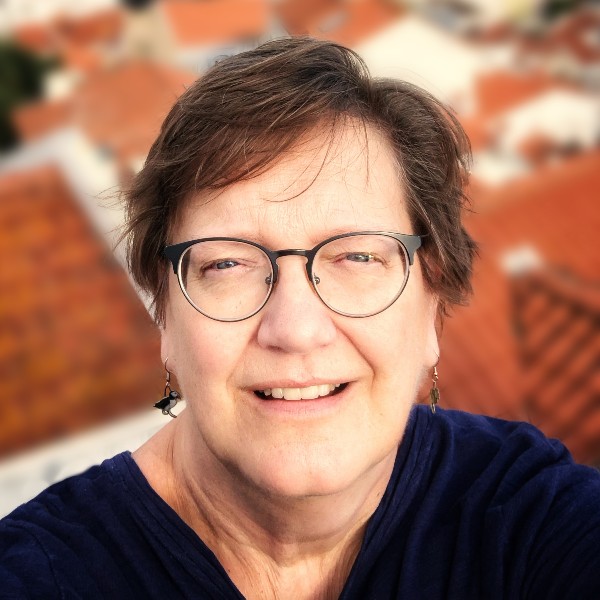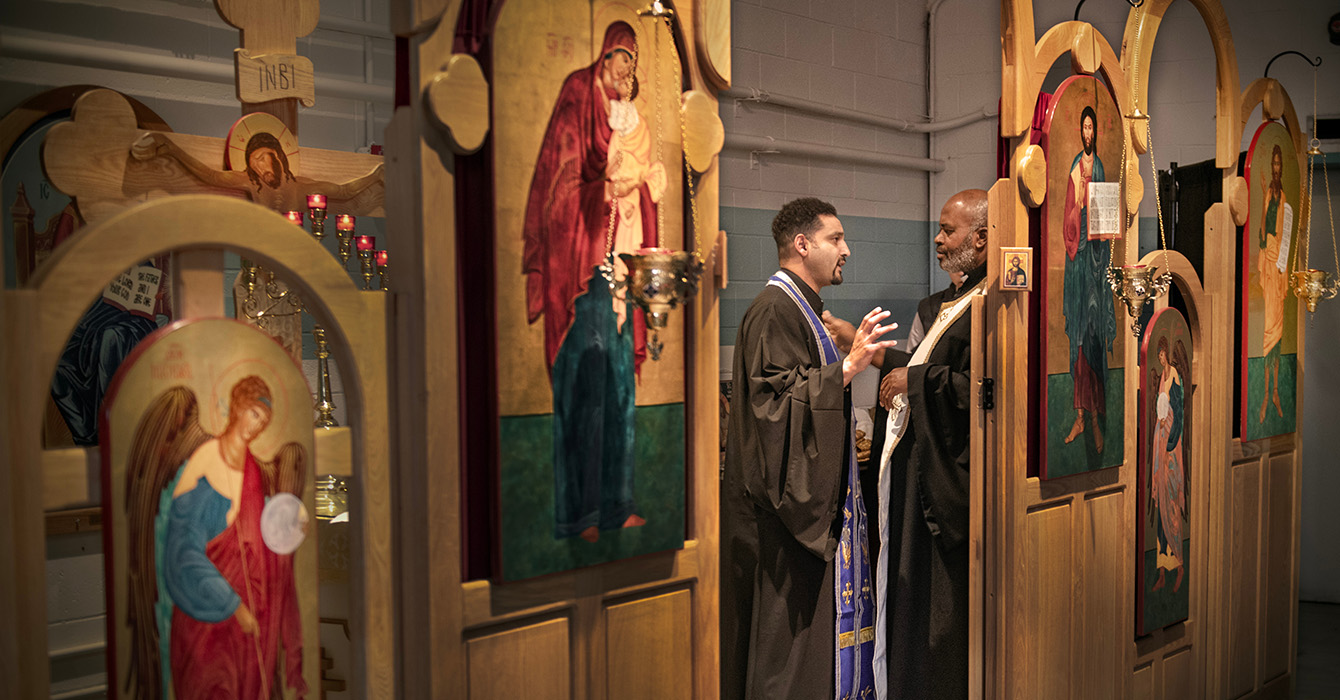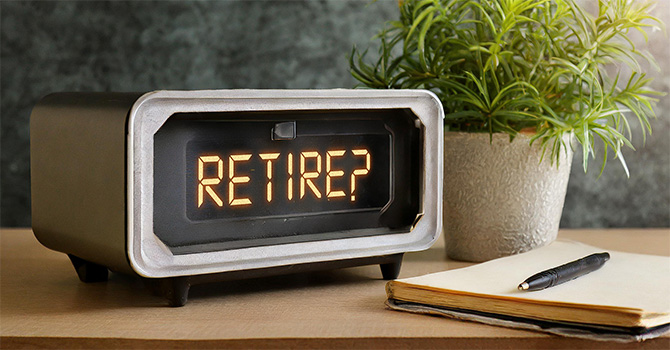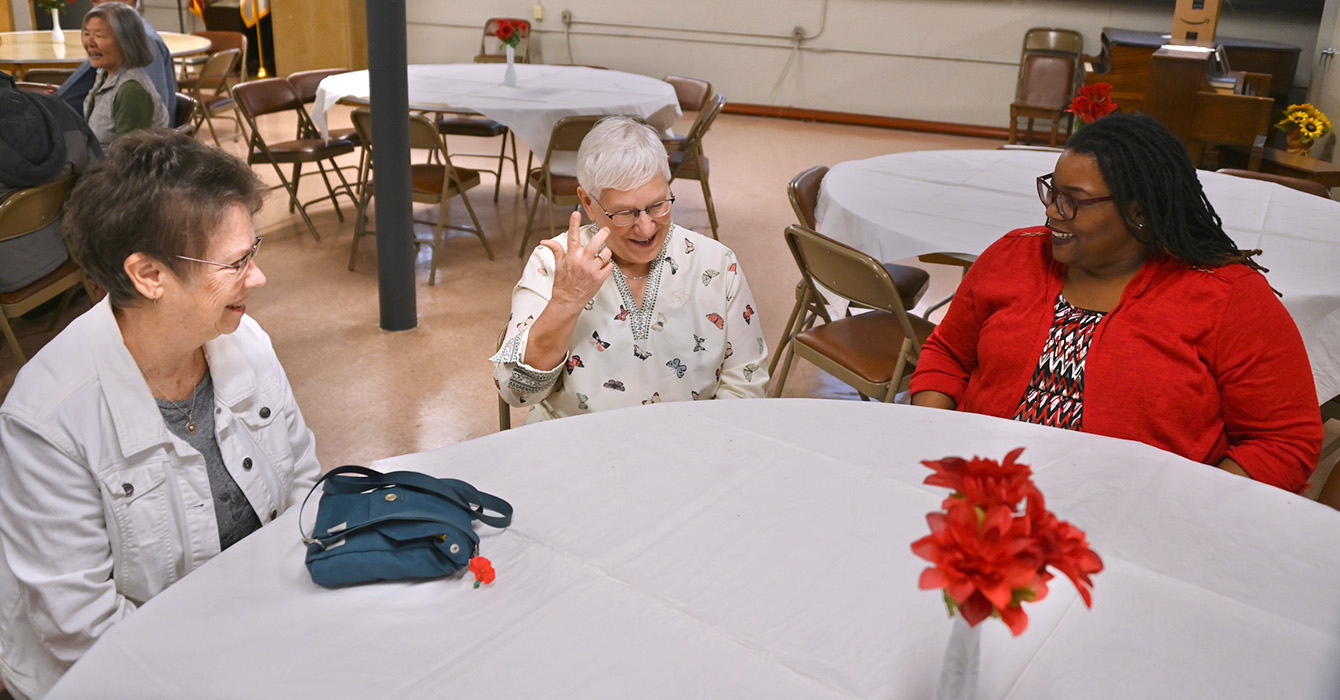On a sunny spring Sunday morning, the people of Park Church Co-op gathered for worship in their historic sanctuary, in the Brooklyn, New York, neighborhood of Greenpoint. The pews were totally empty. Instead, the congregants sat in an oval of chairs arranged on the chancel, around the communion table. Attendance that day: nine.
Simply by virtue of the body count, the church might appear to be failing. Once, more than 200 worshippers filled those pews on a typical Sunday. Yet since 2013, when the Rev. Amy Kienzle took over as pastor of what was then called the Lutheran Church of the Messiah, the congregation has shown signs of vigorous life and vibrant ministry.

It has flung open its doors to the community’s artists and musicians, hosting dance parties, art exhibitions and concerts. It has built a robust calendar of spiritual offerings, including a weeknight compline service that brings ancient chant and medieval polyphony to a neighborhood more accustomed to emo angst and indie rock. And two years ago, in a signal of its posture of partnership and of welcome to believers and nonbelievers alike, it rebranded itself the Park Church Co-op.
Kienzle’s work has begun to draw notice. Earlier this year, Brooklyn magazine named her to its 100 Brooklyn Influencers list, enthusing about Park Church Co-op’s openness to the creative community and writing that “Kienzle’s influence has firmly placed the congregation as the new neighborhood staple.” But Park Church Co-op isn’t just an old church space reborn as a new artistic venue. Under Kienzle, it’s seeking to be a spiritual bridge to people who typically wouldn’t enter a Christian church, and in doing so, it’s re-connecting with its deep missional roots.
How can your church be a bridge to people who are unchurched and perhaps even skeptical of church?
“This church has a tradition of being a community space,” said the Rev. Ann Kansfield, co-pastor of Greenpoint Reformed Church, about a half-mile away. “What Amy is doing is infusing it with some theology and some sense of church.”
A blend of traditional and non-
The recent Sunday service at Park Church Co-op constantly blended traditional and non-. The communion table was set with a pristine lace-edged cloth; the bread was a loaf of ciabatta, the wine a bottle of Chateau Diana merlot from the bodega down the street (“That’s all they have,” Kienzle said later). The hymns were old-school, although “Holy, Holy, Holy” was accompanied by banjo.

When the time came for the offering, Kienzle told those gathered that “we do have Venmo and PayPal, so if anyone does want to do an electronic offering, you can.” The offertory, sung by music director Josh Martin, was “Doubting Thomas,” a Nickel Creek song.
Kienzle wore a clerical collar, but also tan wingtips and gray slacks that allowed a tattoo above her left ankle to peek out. The tattoo is of the Greek word χάρις, which means “grace.”
During her reflection on the morning’s Scripture passage -- John 20:19-31, the story of Thomas asking to see and touch Jesus’ wounds -- Kienzle spoke candidly about the gifts of others’ testimonies. In her college years, when she returned to the church of her childhood, Kienzle met a woman named Lottie, whose hands were gnarled from chronic arthritis. Even so, Lottie’s radiant smile “was untouched by the pain she experienced on a daily basis,” Kienzle said.
Once, Lottie claimed to have seen Jesus standing at the foot of her bed.
“That, amid her suffering, gave her hope,” Kienzle said. “‘We have seen the Lord,’ the disciples told Thomas. It’s an unbelievable assertion! Those who see the specter of dead people are kind of crazy, right? But her story helped my faith journey. … Our willingness to be vulnerable and to share our faith story with others can be the means for them to see the Lord.”
If the congregants were surprised by Kienzle’s story of a mystical encounter, they didn’t show it.
Kienzle has always been drawn to things unseen, to the unprovable, to the mysterious. “It took me a long time to stop believing in Santa,” she said later.
She grew up on Long Island. Her father was Lutheran, her mother Episcopalian. They weren’t churchgoers, and she recalls her mother disavowing organized religion. Yet Kienzle was baptized Lutheran, and she and her sister were raised attending Sunday school, she said, even if “sometimes we got sent in a cab.”
When she got to NYU, she chose to focus on medieval and Renaissance studies, specializing in art history: “The Bible stories were there in living color.”
The summer before her sophomore year, she decided to stop by her old church to see what time services were.
“I was bored,” she said. “But I also felt like something was missing. Maybe it was the ritual. Maybe it was the mystery.”
Within months, she was on several church committees. And after finishing college, she went to seminary.
“My mom was like, ‘What happened to art?’”
Ordained in 2007, Kienzle spent six years at a Lutheran church in Dearborn Heights, Michigan, before accepting a call to Greenpoint, Brooklyn, as a mission developer. Her task, supported by well over $100,000 a year from the ELCA: to find new life in an old church.
Neighborhood of change and opportunity
The first time I met Kienzle, we ate at an old-school Greenpoint diner called Manhattan Three Decker, which has served bacon and eggs for at least a half-century. The second time, we ate at Littleneck Outpost, a three-year-old cafe/boutique/eatery. That day, the special was an $8.50 breakfast sandwich with egg, smoked cheddar and wild ramps on ciabatta. You could also buy $15 canvas tote bags and $24 sea-salt candles from Sweden.
The contrast between the two reflects today’s Greenpoint. It’s a neighborhood of change and opportunity, tensions and challenges. Just as the Irish and Germans that populated the area eventually gave way to waves of Polish immigrants, the Poles are now being replaced by waves of hipsters and young professionals.
Amid change, nothing is certain, and promising starts often succumb to disappointing realities -- including at this very church. In 2009, The New York Times published an article praising the work of Kienzle’s predecessor, the Rev. Griffin Thomas, opening the church up to arts and community organizations. But by the time he left in 2012, after nearly eight years at the church, attendance was no higher than it had been when he arrived.
What Kienzle has done is to integrate history, outreach and spirituality in a way that the church had not before. The Lutheran Church of the Messiah was planted in 1899 as a missional congregation. Several years ago, as Kienzle cleaned out the detritus that had accumulated throughout the building over the decades, she found an old booklet containing the church constitution as well as an advertisement for the congregation. It said, “English Evangelical Lutheran Church of the Messiah,” and then, underneath that, in small type, “Park Church,” a reference to its location right across the street from Monsignor McGolrick Park.
“We’re reclaiming that history,” Kienzle said, “though we have to speak a different language now.”
How can your church’s history and tradition be reclaimed in new ways?
Over the past few years, she asked the various groups that operate out of the church -- including a farmers market, the Brooklyn Children’s Theatre and a monthly dance party called No Lights, No Lycra -- whether she could call them “ministry partners.” They all agreed -- intriguing, since none of the nine are Christian organizations.
Take the one led by Debbie Attias, who identifies as Jewish. It’s a weekly fitness class called Dancorcism (yes, “dance” + “exorcism”).
“When I first approached Amy, I was like, ‘Oh, Dancorcism sounds like the devil! She’s going to think I’m crazy!’” Attias said. “But we’re exorcising our everyday demons -- anger, fear, guilt. It’s basically energy work and healing and dance therapy disguised as a dance-and-aerobics class.”

Each session works through the seven chakras -- the body’s energy centers, according to ancient Indian spirituality -- with music specially chosen for each. For a recent session, the soundtrack for the power chakra -- roughly, the torso -- was “Oh Bondage, Up Yours,” from the 1970s British punk band X-ray Spex.
“It’s very angry,” Attias said. “A lot of people are feeling stressed out with the political climate. At the power chakra, you can have a temper tantrum and let your body express frustration and chaos and just release your energy.”
The session always culminates with the crown chakra, “when you realize that everything is connected and everything is love,” she said. “At the end, everyone is dancing together. There is no choreography anymore. We are making eye contact and giving each other what I call dance magic -- essentially, a blessing with your dance moves.”
For this, Attias chose “Sunny,” the disco-driven 1976 song from Boney M.

What are the stereotypes of pastors and church people? How does your church fit them? Defy them?
That journey from negative energy to positive roughly tracks Attias’ own attitudes toward Christianity. Her relationships with Kienzle and Park Church Co-op’s congregants have challenged her stereotypes “of what a pastor was supposed to be and what church people are supposed to be,” Attias said.
“Here I am, part of a church now,” she said. “And I like it! I’m proud of it! I like telling people I’m at my church, and they’re like, ‘What are you talking about?’”
Such testimonies hearten Kienzle in her efforts to meet Greenpoint’s people where they are.
What does it mean to meet people “where they are?” How open is your church to difference and to new experiences?
“People move closer to you if you stay open,” she said. “They begin to trust you.”
Attias also co-hosts a monthly meditation session with Kienzle called Sound Church. Kienzle noted that the meditative “sound bath” led by Attias regularly includes readings of inspirational work, often poetry. It’s not a Christian service, and for months, Attias was adamant that it remain nonsectarian. But recently, she approached Kienzle to say that she’d been reading and pondering Psalm 23. Might that work at Sound Church as a prayer?
Reflecting on mistakes
Lately, Kienzle has been reflecting on the mistakes she made in her first few years at the church. She has occasionally let things slip beyond her grasp. Wanting to be welcoming, “sometimes we’ve said yes to things we shouldn’t have,” she said.
Two years ago, for instance, the church agreed to be the venue for a feminist symposium. During one session, 16 people took off all their clothes and ran around the church naked. A startled church member took a picture and sent it to everyone.
“I believe in pushing the boundaries of church,” Kienzle said. “But I’ve also learned that we have to ask more questions and be careful to explain why something is allowed to be here.”
Last fall, she began incorporating more structure, drawing better boundaries. There are now standard booking forms that all who want to use the church as an event space must fill out. She created a team to share responsibility for managing musical performances, which constitute the bulk of demand. And with the co-op’s ministry partners, she drafted a statement of shared values -- a reminder that Park Church Co-op is not just a historic building but also a space of spiritual community.

“It’s a challenge,” Kienzle said, “to discern who’s really committed to the place and who just wants to use it.”
She has welcomed new partners such as Matt Morello, a musician who lives around the corner. After running into Kienzle at the local farmers market, where she was blessing vegetables, he approached her last year to suggest starting a monthly compline service. Held on the first Thursday of each month, the candlelit half-hour service of sung prayer draws on ancient tradition, Morello said.
“Some of the chant is very old -- that could be the first millennium,” he said. “The polyphony that we sing, the multipart stuff -- it’s usually 1400 to 1600.”
While Morello’s careful to note that “it’s not just a concert,” he’s equally adamant that the experience is up to the attendee to define: “It is a presentation of sacred music in a sacred space that I think lets us explore what those things are.”
Such programming helps move Kienzle toward her goal of expanding Park Church Co-op as a spiritual center.
“We need to figure out how to grow this worshipping community and make that a priority in a way we weren’t before,” she said.

How do you measure success?
But how do you measure success on that front? Attendance burgeoned to nearly 100 people last Christmas Eve. And some non-holiday Sundays, enough people have attended that the chancel was crowded, so now they’re experimenting with going back to the pews on the first Sunday of each month.
Yet while church attendance might be one indicator of success, it isn’t the only one, Kienzle said. Neither Attias nor Morello attends on Sunday mornings, nor do they plan to. And in this neighborhood, residents’ personal barriers to entry at 11 a.m. on Sundays might be too high to overcome.
“I know we’ve impacted people’s lives and changed their minds about the church,” she said. “People say, ‘I’m so glad this church is here.’ But that doesn’t mean they’re going to come on Sundays and forgo brunch, or that they will make it the center of their lives.”
This points to important underlying questions not just for Kienzle and Park Church Co-op but for the church beyond: What does “church” mean today, particularly in a transient, urban context like Greenpoint -- and what should it mean? What are the unchangeable aspects of church, and what must be contextualized? How does God appear, and how can the people of Jesus bring their welcome and witness to the world?
What are the essentials of church? How can your church attract nonbelievers without sacrificing core beliefs?
“I do struggle a bit,” Kienzle said. “I am a Christian pastor. The call is to Word and sacrament. My call is to be a bridge. But how do I do that?”
The Rev. Lamont Wells, Kienzle’s ELCA mission-development supervisor, is watching Park Church Co-op’s numbers. He agrees that church membership or Sunday attendance stats are not all that matter; participation in other church-sponsored activities counts for something, too.

But while he’s optimistic about the ministry at Park Church Co-op, Wells said, “across the board, I’m not optimistic about the sustainability of many of our ministries.”
The ELCA does full reviews of missional projects like Kienzle’s every 18 months, and ministry sustainability -- a particular challenge for churches of this size -- will no doubt be a criterion for evaluation.
“We can’t continue to invest missional dollars forever,” Wells said, especially given the high cost of living and working in New York. “It’s a tough time to do ministry there.”
Others in the neighborhood validate Kienzle’s work so far -- and see promising signs.
“Amy should have collapsed like a cheap suit when she arrived and there were three people in her church. She didn’t,” said Kansfield, the Greenpoint Reformed Church co-pastor. “She has a deep sense of her own personal faith and lives it out in a way that is very attractive to others -- it’s generosity and compassion and creativity and connectedness to the people around her.”
And what is all that, if not good news?
Questions to consider
Questions to consider
- To whom is your church in mission? Who, if anybody, is it trying to reach outside of the congregation?
- How can your church be a bridge to people who are unchurched and perhaps even skeptical of church?
- What are the essentials of church? How can your church attract nonbelievers without sacrificing core beliefs?
- What are the stereotypes of pastors and church people? How does your church fit them? Defy them?
- How can your church’s history and tradition be reclaimed in new ways?
- What does it mean to meet people “where they are?” How well does your church do that? How open is it to difference and to new experiences?
- Who are potential ministry partners in your church’s neighborhood?













